|
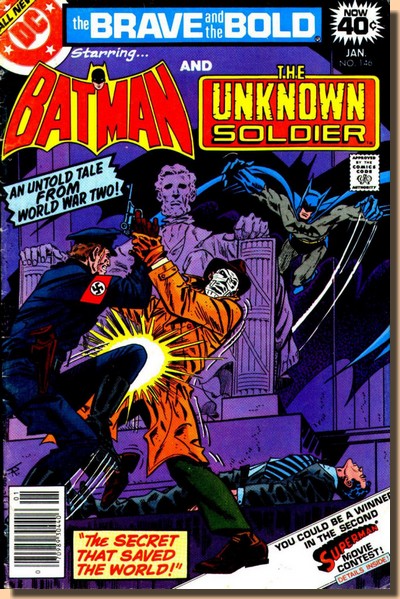 |
|
THE
BRAVE AND
THE BOLD
#146
BATMAN BRINGS DOWN A
SPY
BOB HANEY THINKS UP A YARN
JANUARY 1979
"The Secret
that Saved a World!"
(17 pages)
Cover pencils & inks - Jim
Aparo
Cover colouring - Tatjana Wood
Script - Bob Haney
Pencils - Romeo Tanghal
Inks - Frank McLaughlin
Colours - Jerry Serpe
Lettering - Ben Oda
Editor - Paul Levitz
|
|
| |
| One of those comic book
series with an intriguing title, The Brave and the
Bold started out as a bi-monthly anthology in August
1955 featuring characters from past ages such as Viking
Prince, the Silent Knight, or even Robin Hood. Following
DC's successful attempts at reviving and updating
superheroes from the Golden Age (kick-started by the
Flash in Showcase #4 in October 1956), Brave
and the Bold was changed into a try-out title as of
issue #25 (August 1959), presenting a succession of
(mostly successful) new concepts which would often move
on to their own title. The most significant of these was
the Justice League of America (Brave and the Bold
#28, February 1960) which, as comic book history lore has
it, ultimately spawned the Fantastic Four and hence the
whole Marvel Universe (Howe, 2012). |
| |
| Having
previously already run a few team-up
stories, Brave and the Bold #59
(April 1965) featured Batman for the
first time, followed by further
appearances by the Darknight Detective
(#64 and #67-71). With the TV series and
the subsequent Batmania in full swing Brave
and the Bold became a dedicated
Batman team-up title with issue #74
(October 1967), becoming a monthly title
with Brave and the Bold #118
(April 1975) and ultimately clocking up
200 issues until its demise in July 1983. The title takes much
of its renown and fan interest from the
fact that it was the first to feature
Neal Adams' version of the Batman in a
Batman and Deadman team-up entitled
"Track of the Hook" (Brave
and the Bold #79, August 1968), and
his style defines the iconic popular
culture Batman image to this day. Adams
was followed by another fan favourite,
Jim Aparo, who started an impressive run
with Brave and the Bold #98
(October 1971), becoming the principal
artist for the title throughout the
Bronze Age and ultimately pencilling
almost all of the second one hundred
issues of the title.
|
|
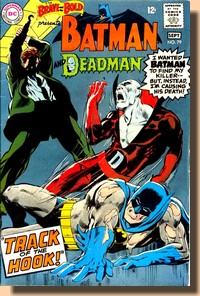 |
|
|
| |
| One of those few issues
Aparo did not provide the artwork for is Brave and
the Bold #146 (January 1979) - although he did
pencil and ink the cover - and the rare occasion was
marked by the fact that Romeo Tanghal (pencils) and Frank
McLaughlin (inks) were billed as "guest
artists". |
| |
 |
|
Romeo
Tanghal (*1943) is a self-taught Filipino artist
who came to the US in 1976 and worked for both DC
and Marvel. Possibly best known as inker for the
Perez run on the Teen Titans, his first
pencils on Batman were published in February 1977
(Batman #284). He is active on the
convention scene and describes himself as a "retired
comic book illustrator/inker" [1]. Frank McLaughlin (*1935)
worked as a technical illustrator before being
hired by Charlton Comics whose art director he
became in 1962. As of 1972 he began to work for
both DC and Marvel, pursuing a career in inking
which included some of Ernie Chan's pencils on
Batman in Detective Comics in 1975/76.
He has taught and published books on comic book
pencilling and inking. |
|
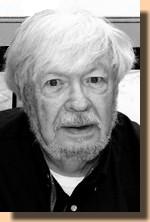 |
|
| |
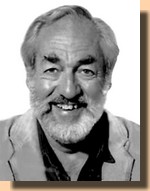 |
|
Contrary
to both Tanghal and McLaughlin, whose
combined artwork efforts would remain
their sole contribution to the 200 issues
run of Brave and the Bold,
writer Robert G. "Bob" Haney
(1926-2004) was almost a part of the
inventory of the title. Having entered
the comic book industry in 1948, he
started working for DC in 1954 [2] and would continue
to do so for almost 30 years during which
Haney scripted just about every sort of
comic book DC published (Evanier, 2004).
Sometimes called Zany Haney, he was in
actual fact one of the few people at DC
in the mid-1960s who "understood
that Marvel was successfully reinventing
the super-hero comic for the current
generation" (Evanier, 2004) and
tried to bring some of that "Marvel
flavour" to the stories he was
writing for DC, including his very own
(and sometimes completely off-beat)
version of Stan Lee's hyperbole. |
|
|
| |
Brave and the Bold came
to be placed firmly in the writing responsibility of Bob
Haney - matter of fact the letters page of Brave and
the Bold #146 informed readers that Haney would be
taking his first holiday break in ten years and thus not
script issue #147. Haney's first script for the title had
appeared in issue #4 in February 1956 (a Viking prince
story), and he came up with the Batman team-up formula
when the title had experienced sagging sales.
"I soon
realized that a super-hero team-up concept was the
only way to revitalize the book. I needed a
wheelhorse. Superman was out. His editor jealously
guarded that empire. So Batman became the B&B
mainstay. It worked. Without him or with some minor
or non-super teammate, sales would tumble. So I
pursued a policy of repeated link-ups with those
characters the readers obviously favored via their
sales response. Also, I wanted the spooky dark night
Batman image of his original days. Such artists as
Neal Adams and the redoubtable Jim Aparo brought this
vision to panelled reality."
["Bob Haney", in Best of the Brave and the
Bold #5 (1988)]
With each and every story
Haney would just grab the Batman and run, completely
defying continuity, convention - and sometimes common
sense. He simply wrote the Darknight Detective's team-up
adventures the way he wanted to, sometimes even in
outright contradiction to established DC Universe and
even core Batman conventionalities. So much so that
Haney's Brave and the Bold Batman would be
deemed to not be the Batman from Earth-One (i.e. within
Silver and Bronze Age continuity) but rather a Batman
living in an alternate reality called "Earth-B"
- a term coined by Bob Rozakis (Eury, 2013).
"Haney
didn’t just embrace the wild, anything-goes
attitude of the Bronze Age, he strapped a jetpack on
it and rocketed it to a headquarters at the center of
the sun. He set the gold standard for an entire era
of DC comics, writing stories in which no premise was
too insane to make a grand adventure and no character
was off-limits for a team-up with Batman."
(Sims, 2011)
To some, however, this style
and approach seemed ridiculously irreverent, and Haney's
hyperbole ("read it [i.e. Brave and the Bold]
ever, miss it never!") didn't go down well with
others either who felt it was "strained"
(Daniels, 1995). Haney, who was ahead of the pack in the
Sixties, gradually came to be perceived as someone who
had fallen hopelessly behind by the mid- to late
Seventies (Evanier, 2004).
"Paul Levitz
became editor with #139 (January/February 1978) and
felt that Haney's scripts were too old fashioned so
(...) he started using other writers in rotation with
Haney (...). Levitz also started to tell Haney
which characters to use instead of leaving the choice
up to Haney who had always used whatever characters
he wanted regardless of continuity issues.
Haney chose his characters based on what sold
well and who fitted the plot. Levitz was more
concerned in building a consistent continuity based
on the Marvel model and Haney was eased out to be
replaced by writers who had defected from Jim
Shooter's Marvel such as Gerry Conway and Marv
Wolfman." (Simayl, 2012)
Haney's final Brave and
the Bold story teamed up Batman and Kamandi in issue
#157 (December 1979). In the very early 1980s he
struggled to produce material that DC's editors did not
consider dated and old fashioned, and ultimately left the
comic book industry (Evanier, 2004).
|
| |

|
| |
| Bob Haney was quite capable
of whipping up tightly plotted scripts which became near
classics (e.g. his Brave and the Bold stories
illustrated by Neal Adams), but he could also produce
extremely loose plots with lots of holes and very little
overall sense. "The Secret that saved a World"
clearly belongs in the latter category, and starts out
with a splash page featuring a scene which never actually
happens this way in the story about to unfold. |
| |
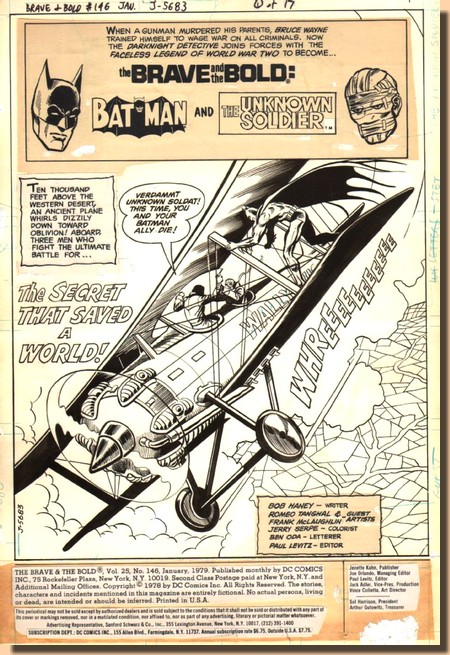 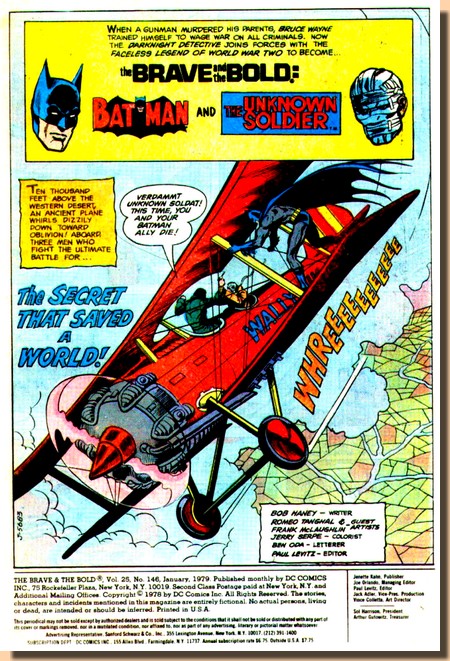 |
[Left] Original
artwork by Romeo Tanghal and Frank
McLaughlin for the splash page of Brave
and the Bold #146 (scanned from the
original) and [Right] the same page as it
appeared in print
|
|
| |
| The fact that this is an
"Earth-B" story if ever there was one is not
only highlighted by the fact that Batman is teamed up
with the Unknown Soldier in what must thus be an "untold
tale from World War Two" (as per the cover
blurb), but also put straight in the very first story
panel which informs readers that this story takes place
"years ago on a world not our own, when that world
was covered by the dark clouds of World War Two". |
| |
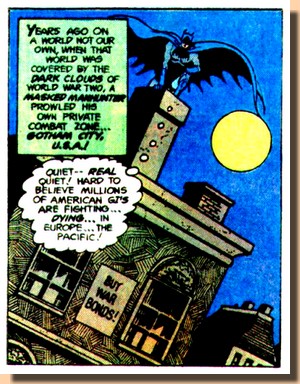 |
|
Investigating
the murder of a German
physicist, the Batman
discovers a Nazi dingy
off Gotham shore. He
contacts the FBI in
Washington and there
meets the Unknown
Soldier. 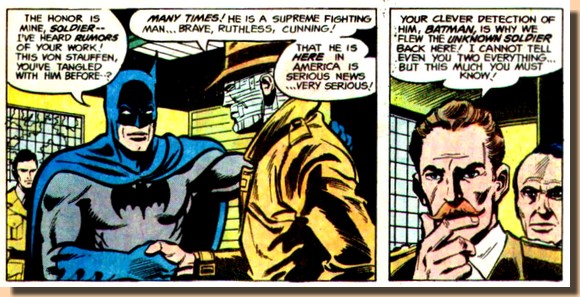
|
|
|
|
|
| |
| Upon
learning that the Unknown Soldier's
arch-foe, Count Klaus Von Stauffen, is
quite probably acting on orders given to
him by "Herr Mustache"
(i.e. Hitler) himself and attempting to
steal secrets concerning the American
atomic weapon plans, the Batman and the
Unknown Soldier team up to prevent Von
Stauffen from smuggling any secret
documents out of the country. The Nazis have
seemingly infiltrated the embassy of the
small South American country of San Pedro
and are using it as their base of
operations. Attempting to buy large
quantities of uranium from a friend of
Bruce Wayne, Von Stauffen kills the
potential supplier (on the steps of the
Lincoln Memorial, no less) when the
latter wants to turn to the authorities
because he has become suspicious.
|
|
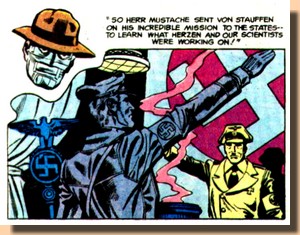 |
|
|
| |
| Batman and the Unknown
Soldier then trail Von Stauffen to New Mexico where he
has hired an old bi-plane in order to take aerial
pictures from the top secret Los Alamo complex. The
Unknown Soldier poses as the pilot but is found out in
mid-air by Von Stauffen. As a result of the ensuing
struggle the plane crashes, leaving the Unknown Soldier
slightly injured as Von Stauffen jumps clear and flees
(contrary to the splash page, Batman is on the ground
while all of this happens). |
| |
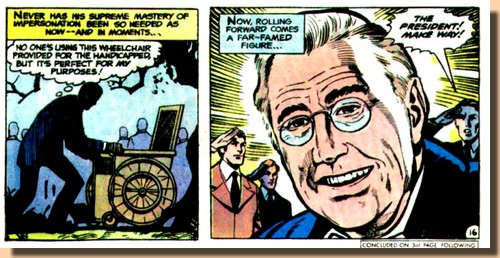 |
|
Listening
in to the telephone calls
of the San Pedro embassy
the Batman and the
Unknown Soldier learn
that Von Stauffen is
seemingly about to meet
his contact, most
probably wanting to hand
over the secret plans. Batman
deciphers his code
description of the place
and time, and the two
trail Von Stauffen to the
official memorial day
celebrations in
Washington DC. Disguising
himself as President
Roosevelt, the Unknown
Soldier manages to seize
a rose from Von Stauffen
which he noticed the Nazi
spy had picked up only
moments earlier.
|
|
|
|
|
|
| |
| However, as "the
president" takes the rose from Von Stauffen, the
Nazi hurries from the scene, making the Unknown Soldier
instinctively realize that there is some other kind of
foul work going on. |
| |
| With
a split-second reaction
the Unknown Soldier grabs
an explosive device from
one of the tombs and
hurls it out of harm's
way only moments before
it explodes... and would
have taken with it half
of America's leaders. While
Batman is rueful about
Von Stauffen having given
them the slip and
probably hiding at the
San Pedro embassy, the
Unknown Soldier assures
the Darknight Detective
that he will be preying
and waiting on his
arch-enemy - a story to
be told in a future issue
of The Unknown
Soldier ...
|
|
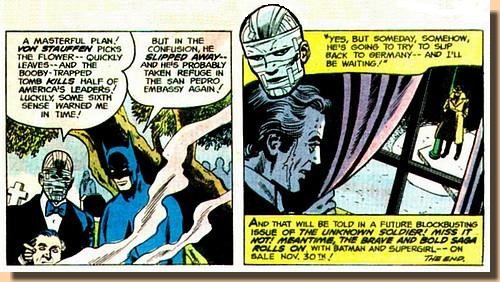 |
|
|
|
|
| |
| The continuation of the
story refered to in the last panel did, by the way,
actually take place - although not before almost a year
had passed, in Unknown Soldier #234 and #235,
cover dated December 1979 and January 1980. |
| |


|
| |
| Haney's team-up for Brave
and the Bold #146 certainly generates a pronounced
interest on the metaplot level as Batman, historically
speaking, barely fought Nazis at all back in the actual
days of WW2 while other superheroes were busy punching
Hitler and the "Japanazis" every other day. In
fact, the only time Batman (and Robin) came to grips with
Nazis was when they foiled a gang of German agents in Batman
#14 (January 1943) in a story titled "Swastika over
the White House". Other than that, the Batman
stories more or less completely ignored the war - the
most readers would see was the Dynamic Duo advertising
war bonds on the covers of Batman and Detective
Comics. |
| |
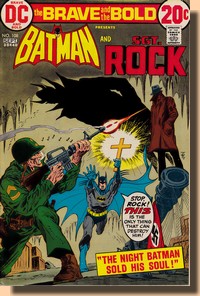 |
|
Bob
Haney saw the raw potential of using his
own version of the Darknight Detective in
a war story context, and the successful
range of DC war comics (popular ever
since the 1950s) provided him with a
protagonist in the form of Sgt Rock (who
had made his first appearance in Our
Army at War #83 in June 1959) for
several team-ups with Batman in several
issues of Brave and the Bold,
starting with issue #84 in June 1969. Haney's loose
handling of timelines and continuity
didn't really meet the approval of fellow
writer Robert Kanigher, who had
co-created Sgt Rock with artist Joe
Kubert and felt that the character should
be rooted and displayed in WW2 days only.
This didn't stop Haney from writing
present day team-ups between Batman and
Rock, including the somewhat oddball yet
at the same time fascinating and poignant
tale in Brave and the Bold #108
(August 1973) where the Sergeant from
Easy Company trails a satanic figure
which he believes to be Hitler.
|
|
|
| |
| Including the Führer
- refered to as Herr Mustache - in Brave and
the Bold #146 was thus no first for Bob Haney, but
using the Unknown Soldier - another DC war comics
character created by Kanigher and Kubert - was. First
appearing in Our Army At War #168 (June 1966), the
Unknown Soldier is an interesting concept: As the
"man whom no one knows - but is known by
everyone", his head and face are so severely
disfigured that he typically has it completely wrapped in
heavy bandages. Adding to that air of mystery surrounding
his person, he is deployed on various missions as a US
intelligence agent, and the success of his missions
relies to some extent on his ability to produce masterful
facial disguises, allowing him to assume the identity of
almost any man using latex masks and make-up. |
| |
| Bob
Haney had more than just a hand in the
shaping of DC's war comics. He had penned
the script which featured a character
seen by many as the prototypical Sgt Rock
character in April 1959 and hence his
true first appearance (in Our Army at
War #81), and he wrote the Unknown
Soldier feature in Star Spangled Wat
Stories throughout 1972 and 1973 and
then from 1977 to 1982 in his own title, The
Unknown Soldier. Brave and the
Bold #146 would be the first and
last time Batman and the Unknown Soldier
would team up, and rather than transport
the latter through time Haney opted to
label the story a "forgotten tale of
WW2" on one of DC's many
"parallel earths" where the
Batman is active during that period of
history.
It's not all
change, however, as Haney for example
sticks to the "no guns" rule of
the mainstream Batman Universe and even
has the Darknight Detective make an
explicit comment on this point.
Otherwise, however, the story makes
little overall sense as the object of
Count Klaus Von Stauffen inexplicably
changes (from stealing secret plans for
atomic weapons to blowing up America's
leaders) upon the turning of a page and
only few panels left to the story's
ending.
|
|
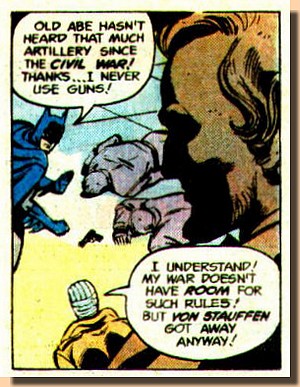 |
|
|
| |
| To make matters even worse,
Von Stauffen's modus operandi for setting off
the explosive remains a complete mystery - the rose which
the Unknown Soldier disguised as President Roosevelt
takes from must have something to do with, but how and
why will probably remain Bob Haney's secret for ever. On
top of this rather desperately thin plot the almost
shapeshifting-like disguises employed by the Unknown
Soldier are little more than a deus ex machina,
highly improbable devices to push on a story which
otherwise would be stuck completely. The setup with Batman and the Unknown
Soldier fighting Nazi spies is promising, but
unfortunately "The Secret that saved a World"
loses speed very quickly and then collapses right across
the finishing line. But even so, it is a facet of the
Bronze Age "Earth B" Batman and the character's
long publication history. Throughout those 75 years
Batman stories have - quite naturally - always varied in
quality, but with the Batman, even a "miss"
will always contain points of interest and a certain
entertaining quality.
|
| |


|
| |
| Brave and the Bold #146
went on sale on October 26th
1978, and its in-house ads and editorial pages afford a
glimpse of DC Comics as the 1970s Bronze Age was about to
unwind. Strangely
enough, one of the advertisements included the very comic
book readers were holding in their hands as DC was
pushing "Super-Team Thrills" with Brave
and the Bold and the then only recently launched
Superman team-up title DC Comics Presents. Other
in-house ads included a Superman The Movie
contest, subscriptions to DC's Direct Currents
newsletter, the tabloid-size Famous First Edition
of Superman #1, plus the at the time new
"Dollar Comics" issues of Adventure Comics
and Unexpected.
|
| |
